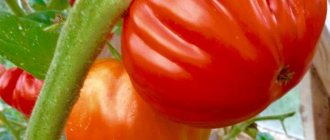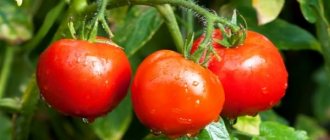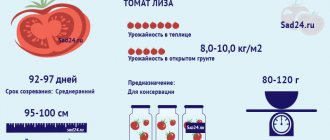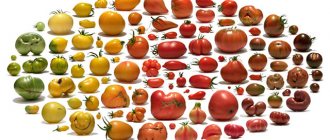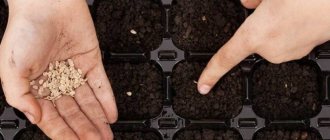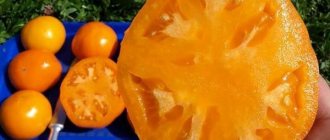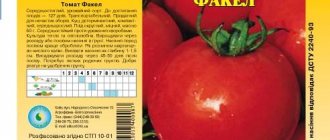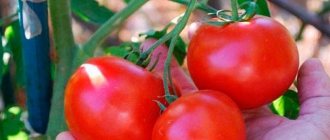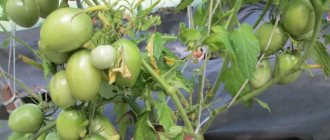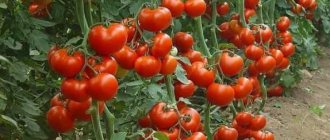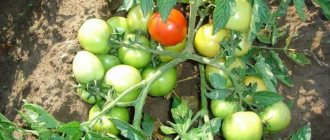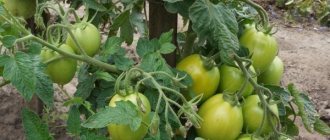The Monastic Meal tomato is loved by gardeners due to its unsurpassed sweet taste with virtually no sourness. Fleshy orange fruits perfectly complement any salads and vegetable dishes.
| Height | Landing location | Ripening time | Fruit color | Fruit size | Origin | Fruit shape |
| Medium height | Greenhouse, Open ground | Mid-early | Orange | Average | Variety | Round |
Tomato “Monastic Meal”: description of the variety
| Variety name | Monastic meal |
| general description | Mid-season determinate variety |
| Originator | Russia |
| Ripening period | 90-110 days |
| Form | Round, slightly flattened |
| Color | Orange |
| Average weight of tomatoes | 140-400 grams |
| Application | Fresh, for juice and pastes |
| Productivity of the variety | 5.4 kg per sq.m. |
| Features of cultivation | Cracking in high humidity |
| Disease resistance | Prevention is needed |
Monastic meal is a varietal tomato with a determinant growth pattern.
In greenhouse conditions and under temporary film shelters, plants reach a height of one and a half meters, and in open ground they rarely grow above 1 meter in height. The bush does not form a bole; on the contrary, at the base of the bush many full-fledged stepsons are formed, which, with proper care, can increase the yield. The ripening period of “Monastic Meal” tomatoes is mid-early, that is, the first fruits can be eaten 90-110 days after sowing the seeds for seedlings. The variety feels great in protected ground and outdoors . Suitable for cultivation in spacious containers. It does not have pronounced resistance to tomato infections.
The fruits of the “Monastic Meal” tomato are distinguished by their unique coloring at the ripe stage. They are similar in color to oranges. At the same time, not only the dense and smooth skin is colored orange, but also the flesh. The shape of the fruit is round, leveled, slightly flattened at the poles. The average weight of one tomato is 140-180 g, however, with a favorable combination of temperature and nutrition of the bush, they can grow up to 400 g .
Each tomato has at least 6 seed chambers, and there is no large amount of liquid in their cavity. The same can be said about the pulp: the dry matter content in them reaches 60%. Tomatoes of this variety are not intended for long-term storage. In the refrigerator they retain their commercial qualities and culinary characteristics for 30-40 days . In this case, it is advisable to place them in one layer, interlayering them with wax paper, or wrapping each fruit in it. Transportation is tolerated relatively well.
You can compare the weight of the fruits of this variety with other varieties in the table:
| Variety name | Fruit weight |
| Monastic meal | 140-400 grams |
| Blizzard | 60-100 grams |
| Pink King | 300 grams |
| Miracle of the Garden | 500-1500 grams |
| Icicle Black | 80-100 grams |
| Lapwing | 50-70 grams |
| Chocolate | 30-40 grams |
| yellow pear | 100g |
| Zhigalo | 100-130 grams |
| Newbie | 85-150 grams |
Tomatoes for the Moscow region: early varieties for open ground
Tomatoes for the Moscow region: domestic selection, open ground, early ripening
- Iceberg variety. Bred by domestic breeders. The weight of the red fruit is about 200 grams, it is fleshy to the touch, has a sweet and sour taste, and is suitable for salads and canning at home. The height of the bush is no more than 50 cm, it is very resistant to late blight.
- Tomato "Alenka". When compared with other tomatoes, it can be considered a pioneer in ripening. The fruits are medium in size (100 grams), juicy, sweet in taste. Under favorable weather conditions, summer residents harvest up to three kilograms of tomatoes from one bush.
- "Ox Ear" The bush is quite low - 50-55 cm. The fruits ripening on it, weighing about one hundred grams, have an elongated convex shape and a red-crimson color. I like its meatiness and delicate taste both in salads and in pickles.
- The variety "Kibits" is one of the very early, low-growing vegetable bushes. These tomatoes for the Moscow region are plum-shaped, weighing up to eighty grams, and have a burgundy color. The peculiarity of tomatoes is their resistance to fungal infections.
- All summer residents love the Medok tomato. This early variety resembles a cucumber, only red. Sweet in taste and easy to care for.
- The wide bush of the “Mongolian dwarf” produces a lot of fruits, the weight of which varies within 200 grams per unit. It makes excellent sauces and adjika.
Tomatoes for the Moscow region: early varieties, foreign selection, open ground
- “Federico” was raised by breeders from Argentina. These tomatoes for the Moscow region are recommended by many land owners to all those who have recently started growing vegetables. If you take care of the bushes, then after 110 days you can get amazing fruits that resemble a pink plum with orange or green veins. One tomato weighs no more than 200 grams, but on the table it looks like an exotic fruit.
- The “Serafino” variety came to the Russian Federation from Greece. It not only amazes with its two-tone color, but also glows like a diamond. If you want to surprise your guests, grow a raspberry-pink miracle on your site! Unfortunately, the fruits cannot be preserved.
- Tomatoes "San Marzano" are recognized tomatoes for the Moscow region. They not only ripen well on the bush, but also feel great in a jar, swimming in their own juice.
The best varieties of tomatoes for the Moscow region: new, early ripening, domestic selection, open ground
- Tomato "Yarik". It differs from its early-ripening counterparts in its large (up to 450 grams) fruits. Has excellent taste. It can grow not only in open ground, but also in a greenhouse if good ventilation is provided. Able to ripen on windows.
- Tomatoes "Tamara". Low-growing, branched bush. The fruits are large (up to 50 pieces per bush), red, each of them weighs about three hundred grams.
- Variety "Cheerful Gnome". Bred by breeder L. Myazina. The bushes are low-growing, up to forty-five centimeters in height, the fruits are similar to plums, weighing up to 90 grams, 100-120 millimeters long. Perfectly preserved.
How do residents of the Moscow region feel about the Bird of Happiness variety?
They love it because no weather conditions are scary for the inflorescences. Tomatoes set even when neighbors spray Colorado beetles. The fruits of the “Bird of Happiness” are bright red and sweet, although they weigh no more than one hundred grams. But they have almost no seeds, and the skin does not crack when canned.
The warm summer period in some Russian regions lasts no longer than 60 - 70 days, so varieties and hybrids whose growing season does not exceed one hundred days are suitable for growing early harvests in open ground.
An old, proven tomato variety was developed more than fifty years ago, but it still competes with new varieties. The variety is distinguished by its friendly yield, which can be harvested approximately two and a half to three months after the mass germination of seedlings.
The height of the bush is on average 60 - 80 cm, the fruits are red, with weak ribbing, weighing 70 - 100 grams. The taste qualities of Siberian early ripening are average. Its main advantages are:
- high yield
- cold resistance
The first tomato harvest can be harvested in 2.5 months
As a drawback, many gardeners note the variety’s tendency to develop brown spot disease. Its fruits are suitable for fresh consumption, juice production, and culinary processing.
Variety White filling
At one time in 1967, this variety became the main one for obtaining an early and relatively friendly tomato harvest on an industrial scale.
High-yielding, managing to produce most of the fruit before the massive spread of late blight, the variety produces tomatoes weighing up to 150 grams, with good taste characteristics. It was actively used in breeding work and gave rise to such varieties as: Mayak, Victor, Pushkinsky.
Variety Snowdrop
One of the fairly new varieties, it has good yield, yields up to 6 - 7 kg per square meter, has excellent taste and is a universal variety. Ripe fruits are red, their average weight is up to 130 grams.
The weight of this variety reaches 130 grams
The advantages of the variety include:
- pleasant taste
- good presentation
The variety can be recommended for cultivation in open ground for sale in small farms and private plots.
Pani Yana variety
Pink-fruited, early-ripening tomato with tasty fleshy fruits. Tomatoes of this variety do not crack, are easily transported, and their weight exceeds two hundred grams. The variety is universal.
Boni-M tomatoes can be considered a real breakthrough. It can be grown by direct sowing of seeds in the ground in late April - early May. After 80 days, numerous, medium-sized fruits, up to 90 grams, begin to ripen. Bushes of this variety do not exceed 40 cm in height and do not require mandatory garter. An excellent option for a beginning gardener.
This variety can not be tied
It may be worth experimenting with colorful early F 1 hybrids such as Black Bunch. Small, cocktail-type tomatoes weigh 40 - 50 grams and are painted a very dark purple color.
No matter how attractive it may be to harvest tomatoes earlier than your neighbors, you should not plant a large number of early tomatoes. Up to 80% of plantings in open ground should be mid-season tomato varieties; as a rule, they are superior to early tomatoes in consumer qualities.
Photo
You can visually familiarize yourself with the Monastic Meal variety of tomatoes in the photo below:
Positive and negative qualities
The main advantage of Monastic Meal tomatoes is that the fruits it produces are large and have an excellent taste. In addition, the plant:
- unpretentious to growing conditions - lighting and heat;
- moderately resistant to pathogens and fungi.
The negative qualities of the variety include the fact that tomatoes are prone to cracking with a sharp increase in soil moisture. It is for this reason that cultivation in greenhouses is recommended, where it is possible to regulate this indicator. When growing on unprotected soil, it is advisable to keep the plant in large containers - if necessary, they can be taken indoors.
tomato Nadezhda F1 - description and characteristics of the variety
Characteristics
The variety was bred by breeders of the Siberian Garden company and included in the State Register of Seeds in 2011. The tomato has good resistance to lack of light and heat, grows well in closed ground, so it can be successfully grown in the Non-Black Earth Region, Siberia and in the middle zone. When planted early and cultivated in heated greenhouses, it can be successfully grown in more northern regions.
Due to the high density of tomatoes and their excellent sweet taste, the “Monastic Meal” tomato variety is recommended for use in salads and snacks. This variety is not suitable for canning, since during heat treatment the fruits crack and the pulp breaks up into small, fine-grained pieces. However, it can be used to make tomato paste or sauce.
The average yield of the variety is 5.4 kg per square meter . You can compare this indicator with other varieties in the table:
| Variety name | Productivity |
| Monastic meal | 5.4 kg per square meter |
| Soyuz 8 | 15-19 kg per square meter |
| Aurora f1 | 13-16 kg per square meter |
| Red Dome | 17 kg per square meter |
| Aphrodite f1 | 5-6 kg per bush |
| King of the Early | 12-15 kg per square meter |
| Severenok f1 | 3.5-4 kg per bush |
| Ob domes | 4-6 kg per bush |
| Katyusha | 17-20 kg per square meter |
| Pink fleshy | 5-6 kg per square meter |
The main advantage of the Monastyrskaya Trapeza variety is the large-fruited and high-tasting qualities of tomatoes, the relatively low requirements of plants for light and heat, as well as moderate resistance to pathogens of fungal and bacterial infections (but only subject to compliance with growing standards). The disadvantage of the variety is the tendency of tomatoes to crack when there is a sharp increase in soil moisture .
That is why the variety is recommended to be grown indoors, where humidity can be regulated, or in open ground when kept in large containers, which can be moved indoors if necessary.
Advantages and disadvantages
According to reviews from summer residents, many complaints arise not so much about the quality of the variety itself, but about the work of seed producers - low germination is noted. Tomatoes themselves have the following advantages:
- Great appearance.
- High taste qualities.
- Good keeping quality and transportability.
- Fruit evenness.
- Stable harvest.
- Limited growth of the bush.
- Possibility of using tomatoes in dietary nutrition.
Disadvantages include the ability to crack - which happens most often with excess moisture, the need to form plants and attach the stem to supports.
Features of cultivation
The main feature of the variety, which is visible to the naked eye, is the orange color of the fruits at the time of their ripening, which indicates the presence of a large amount of carotenes in the fruits. Tomatoes of the Monastyrskaya Trapeza variety are distinguished by their excellent taste, which has absorbed the positive qualities of red-fruited and yellow-fruited varieties. From yellow tomatoes he took sweetness and strong pulp, and from red tomatoes - tomato taste and aroma.
This variety is recommended for dietary nutrition of children and adults with problems of the gastrointestinal tract and other organs. It is recommended to grow tomatoes using seedlings. Sowing must be done at least 50 days before placing the plants in a permanent place - in open ground or a greenhouse.
No more than 4 plants should be placed per square meter . As they grow, tomato seedlings are tied to trellises or stakes; the lower part should be regularly freed from stepsons, leaving one of the strongest ones to form a bush with two stems.
The tomato responds well to regular (1-2 times a week) watering coupled with fertilizing with mineral or organic fertilizers. To ensure the setting and growth of all fruits in the cluster, it is recommended to treat the bushes with growth stimulants from the beginning of flowering.
Read useful articles about fertilizers for tomatoes:
- Organic, mineral, phosphorus, complex and ready-made fertilizers for seedlings and the TOP best.
- Yeast, iodine, ammonia, hydrogen peroxide, ash, boric acid.
- What is foliar feeding and when picking, how to carry it out.
The history of the appearance of tomatoes in Europe
Previously, the fruits were considered poisonous
The tomato was first described by the Italian scientist - botanist P. Mattioli. This happened in the middle of the 16th century, when, after Columbus, European sailors began to explore South America.
Despite the fact that the Mexican Indian tribes called tomatoes golden apples and grew them since ancient times, in Europe for a long time the fruits of this plant were considered not only inedible, but even highly poisonous.
In Europe and Russia, they stubbornly decorated flower beds with tomato bushes and did not want to eat them. In Holland they were grown in pots as indoor flowers. The Portuguese and Italians were the first to massively use tomatoes in cooking, and the warm, mild climate of these countries contributed to their cultivation in open ground.
In Russia, tomatoes began to be cultivated not for beauty, but for food, thanks to the efforts of the Russian scientist Andrei Bolotov.
In Crimea, at the end of the 19th century, the cultivation of tomatoes became widespread. Gradually, culture began to move north. This happened quite slowly, because the temperatures usual for most regions are destructive for heat-loving tomatoes, and if it is not warmer than 10 outside, they stop growing and developing.
By the mid-twentieth century, varieties and hybrids were obtained not only for the south and central Russia, but also for the Urals and Siberia. Currently, almost 500 varieties are recommended for cultivation in open ground.
Today there are a huge number of tomato varieties.
It is important to remember that modern varieties of tomatoes differ not only in appearance and taste, but primarily in ripening time:
- very early
- average
- late
In order for tomatoes to be fresh on the table and to be able to prepare them for the winter, it is necessary to plant varieties with different ripening periods on the plot.
Diseases and pests
The Monastic Meal tomato is moderately affected by late blight and other fungal diseases. To avoid loss of yield, it is recommended to carry out preventive treatments with Bordeaux mixture or other copper-containing preparations for tomatoes. Also, monthly treatment of plantings with Fitosporin or Fitoverm gives excellent results.
The Monastic Meal tomato is a unique tomato in shape and color that will become a real table decoration. The fruits of this variety contain a lot of vitamins and mineral salts, so it is even suitable for baby food. It is easy to grow if you follow a set of classic recommendations for growing tall tomatoes.
Growing seedlings
To grow healthy and strong seedlings, preparation and sowing of seeds begins in advance - 60-65 days before planting in the ground:
- Purchase or prepare soil from a mixture of turf soil with humus and peat. If necessary, it is treated with disinfectant solutions.
- Prepare the seeds - treat them with a weak solution of potassium permarganate and a solution of microelements.
Sowing is carried out in moist soil in seedling containers to a depth of 5-7mm with an interval between seeds of 2-3cm. The container is tightly covered and placed in a warm place at a temperature of 24-25 degrees.
Seeds germinate quite quickly - after 5-7 days, so it is important not to miss the moment of their germination. To avoid stretching the seedlings, it is important to place the plants in the most illuminated place - on window sills or under artificial lighting lamps.
The soil in the boxes must be kept slightly moist, avoiding waterlogging, in order to avoid blackleg disease, which most often affects seedlings.
Seedlings can be hardened off - placed in cooler conditions (lower the temperature by 5-6 degrees) for 10-14 days, then returned to conditions that are comfortable for the plants.
Useful video
Learn more about the Monastic Meal tomato in the video below:
| Early ripening | Mid-late | Mid-early |
| Garden Pearl | gold fish | Em Champion |
| Hurricane | Raspberry miracle | Sultan |
| Red Red | Miracle of the market | A lazy man's dream |
| Volgograd Pink | De Barao Black | New from Transnistria |
| Elena | De Barao Orange | Giant Red |
| May rose | De Barao Red | Russian soul |
| Super prize | Honey fireworks | Bullet |
If you find an error, please select a piece of text and press Ctrl+Enter.
Description of the harvest
Tomatoes of the Monastyrskaya stol variety, when ripe, acquire a unique color. Their color is similar to that of oranges. Moreover, the orange tint is not only in the skin, which is distinguished by its density and smoothness, but also in the pulp itself.
Tomatoes have a smooth, rounded shape, slightly flattened on the sides. The strength of each fruit reaches from 140 to 180 grams. So, with good plant nutrition in combination with favorable weather conditions, the yield of one tomato can reach up to 400 grams.
Each fruit contains less than six chambers with seeds, and they do not contain a whole series of liquids. The same applies to the pulp, which contains not less than 60 percent of dry matter.
Fruits of this variety have a short shelf life. If you store them in the refrigerator, they do not lose their unique taste and presentation for one to one and a half months. In this case, it is better to place them in one layer, inserting wax paper, or wrapping it around both tomatoes. The fruits are transported quite well.
The best varieties of tomatoes with descriptions
Before you accurately choose a variety or hybrid of tomatoes, you need to decide where exactly they will grow.
For open ground, low-growing varieties that will ripen early are more suitable. Mid-ripening species in good summer weather can produce a fairly good harvest, but they are susceptible to microflora, which can destroy most fruits.
tall varieties and various hybrids in greenhouses . Here you can plant absolutely any tomatoes, even late-ripening ones.
Characteristics of the Beauty tomato and growing a hybrid variety
Tomato Beauty f1 got its name because of its beautiful appearance. During the period of full ripening, Beauty pleases its owners with bright crimson tomatoes. The shape and size of all fruits are almost the same. Tomatoes have elastic skin that is not prone to cracking. This makes them resistant to transportation and long-term storage. Fruit weight – 150-200 g.
What is a Beauty tomato?
The characteristics and description of the variety are as follows:
- The tomato ripens in 100-110 days.
- This is a hybrid variety that is resistant to weather conditions and various diseases.
- High yield and good taste are the main indicators of tomatoes.
- This variety can be grown in any region of our country.
- Tomatoes are planted in open ground in warm areas, and in cold areas - under a film cover. At temperatures below +16…+17ºС the plant dies.
How to grow tomatoes?
How to grow Beauty f1 tomatoes? The seeds are ready for planting by the end of March. They are planted in soil containing peat, sand and ash or purchased with a ready-made substrate. For planting, choose a shallow container. The seeds are planted in a row, maintaining a distance of 3-5 cm. Planting depth is 1 cm. To speed up the process of hatching, the soil is sprayed with water and covered with film. The film covering is not opened until the first shoots appear.
Picking is done after the formation of 2-3 true leaves. At this stage of development, the plant needs warmth and light. Seedlings should be protected from direct sunlight. Instead of watering, it is recommended to spray the soil with a spray bottle once a week.
An important activity is hardening off the seedlings, especially if they are preparing to plant them in open ground. 2 weeks before the intended transplantation, the seedlings are accustomed to outdoor conditions. To do this, they are taken out into the air every day, initially for a few minutes, gradually increasing the time.
Tomato belongs to the determinate species. The plant is not very tall, reaches a height of 80 cm. During the growth process, the stems form and moderately shoot. The trunk stops growing after the formation of 5-6 flower clusters. Since the root system of tomatoes is small, 1 or 2 stems are left during formation. This way the fruits will receive adequate nutrition and will not waste their taste.
To prevent the bushes from getting sick and feel comfortable, you need to plant them in one row at a distance of 50-60 cm from each other. The plant will be greatly supported by tying it to supports. The lower leaves in contact with the ground are removed to facilitate watering and prevent fungal infections.
The soil must be loosened periodically. This action improves the drainage properties of the soil
This must be done extremely carefully so as not to damage the roots. You need to be attentive to the appearance of weeds and remove them in a timely manner.
Weeds feed on fertilizers, which are needed for the development of tomatoes.
Next, we will consider the features of applying fertilizers for tomatoes. When the plant begins to bear fruit, the amount of nitrogen in fertilizers must be sharply reduced or removed. This chemical element promotes the growth of green mass, which is absolutely not necessary at the time of fruit filling.
When setting fruit, the plant needs the components of boron, manganese, iodine and potassium. They affect the meatiness of tomatoes and the high sugar content. You can prepare this dressing yourself. To do this, you need to mix wood ash, boric acid and iodine.
Reviews about the Krasotka variety are positive
People who have been growing tomatoes for many years are advised to pay special attention to the quality of the soil. They believe that the survival rate of tomatoes largely depends on it
In general, gardeners are satisfied with the Krasotka variety. They are especially pleased with the good sweet taste.
Description
The plant is determinate, grows in open ground up to 1 m high, in greenhouses - up to 1.5 m, and has a powerful stem. The bushes are medium spreading, require obligatory staking to a support, the foliage is dark green.
The fruits are set in clusters (6-7 per plant) and have the following characteristics:
- The shape is round, the fruits are aligned, like twins.
- The color of tomatoes when ripe becomes bright orange, “orange”.
- The weight of the fruit is 150-200g, under good conditions it can reach 400g.
- The pulp is very tender, has a pleasant taste, and is completely devoid of acid. The skin is dense and smooth.
Fruit ripening occurs 125-130 days after germination, however, under unfavorable weather conditions it may be delayed. According to vegetable growers, tomatoes ripen well when picked green.
The fruits are used universally - fresh, in salads, in the production of juices and ketchups.
Since the “Monastic Meal” tomato, according to its characteristics and description of the variety, is distinguished not only by the excellent taste of the fruit, but also by its low acid content, it is used for dietary nutrition.
How to grow?
Since “Monastic Meal” is a mid-early tomato variety, it is preferred to grow it in unprotected soil in the southern regions - with long summers.
In areas with more severe climatic conditions, they either grow tomatoes in a greenhouse or use temporary shelters, which allow plants to be planted in the ground earlier.
When growing tomatoes in short summer conditions, it is important to form the plant correctly - into 1 stem. To guarantee the ripening of fruits, it is necessary to normalize the harvest - in the fall, when cool weather sets in, remove flowers and ovaries, which take away nutrition from the ripening tomatoes.
